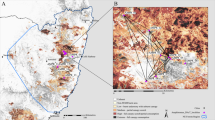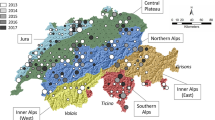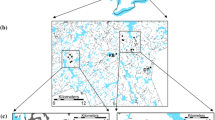Abstract
Two centuries ago large areas of north-west Europe were covered by coherent heathlands which hosted numerous specialized species. Changes in land use made heathlands fragmented and rare, consequently, they are in the focus of nature conservation efforts today. But how large should remaining heathland patches be in order to secure the survival of populations of specialized species? We investigated the genetic diversity at five allozyme loci of Poecilus lepidus, a flightless and stenotopic heathland ground beetle. 29 populations from differently sized heathland patches in north-west Germany were analyzed. Results show a weak but significant genetic differentiation and no evidence for isolation by distance or other patterns of spatial autocorrelation. Linear regression analysis revealed significant relationships between patch size, allelic richness, number of alleles and expected heterozygosity. These findings are explained by severe habitat fragmentation together with strong fluctuations in population size which have been reported for this species in the past. To conserve the vast majority of the species’ genetic diversity for a period of 100 years we suggest to maintain heathland patches of at least 50 ha in size.



Similar content being viewed by others
References
Assmann T, Janssen J (1999) The effects of habitat changes on the endangered ground beetle Carabus nitens (Coleoptera: Carabidae). J Insect Conserv 3:107–116
Assmann T, Dormann W, Främbs H et al (2003) Rote Liste der in Niedersachsen und Bremen gefährdeten Sandlaufkäfer und Laufkäfer (Coleoptera: Cicindelidae et Carabidae) mit Gesamtartenverzeichnis. Inform d Naturschutz Niedersachs 23:70–95
Ayala FJ, Powell JR, Tracy MO et al (1972) Enzyme variability in the Drosophila willistoni group IV: genetic variation in natural populations of Drosophila willistoni. Genetics 70:113–139
Balloux F (2001) EASYPOP (Version 1.7): a computer program for population genetics simulations. J Hered 92:301–302
Brouat C, Sennedot F, Audiot P et al (2003) Fine-scale genetic structure of two carabid species with contrasted levels of habitat specialization. Mol Ecol 12:1731–1745
Cornuet J-M, Luikart G (1996) Description and power analysis of two tests for detecting recent population bottlenecks from allele frequency data. Genetics 144:2001–2014
Darvill B, Ellis JS, Lye GC et al (2006) Population structure and inbreeding in a rare and declining bumblebee, Bombus muscorum (Hymenoptera: Apidae). Mol Ecol 15:601–611
De Vries HH (1994) Size of habitat and presence of ground beetle species. In: Desender K, Dufrene M, Loreau M et al (eds) Carabid beetles: ecology and evolution. Kluwer Academic Publishers, Dordrecht, Boston, London, pp 253–260
De Vries H (1996a) Viability of ground beetle populations in fragmented heathlands. Dissertation, Landbouwuniversiteit, Wageningen
De Vries HH (1996b) Metapopulation structure of Pterostichus lepidus and Olisthopus rotundatus on heathland in the Netherlands: the results from transplant experiments. Ann Zool Fenn 33:77–84
De Vries H (2000) Multiple paternity in ground beetles. Mitt dtsch Ges allg angew Ent 12:441–446
De Vries HH, Kamping A, Van Delden W (1994) A preliminary study of genetic variation in isolated populations of the ground beetle Agonum ericeti (Coleoptera: Carabidae). Proc Sect Exp Appl Entomol Neth Entomol Soc (NEV) 5:109–114
De Vries HH, Den Boer PJ, Van Dijk TS (1996) Ground beetle species in heathland fragments in relation to survival, dispersal, and habitat preference. Oecologia 107:332–342
Degen B, Petit R, Kremer A (2001) SGS – spatial genetic software: a computer program for analysis of spatial genetic and phenotypic structures of individuals and populations. J Hered 92:447–448
Den Boer PJ (1977) Dispersal power and survival – carabids in a cultivated countryside. Veenman & Zonen, Wageningen
Den Boer PJ, Van Dijk TS (1995) Carabid beetles in a changing environment. Wageningen Agri Univ Papers 94:1–30
Descimon H, Napolitano M (1993) Enzyme polymorphism, wing pattern variability, and geographical isolation in an endangered butterfly species. Biol Conserv 66:117–123
Desender K (1986) Distribution and ecology of carabid beetles in Belgium (Coleoptera, Carabidae). Part 2 Studiedocumenten (Bruxelles). 27:1–24
Desender K (2005) Theory versus reality: a review on the ecological and population genetic effects of forest fragmentation on wild organisms, with an emphasis on ground beetles. DIAS Rep 114:49–72
Desender K, Backeljau T, Delahaye K et al (1998) Age and size of European saltmarshes and population genetic consequences for ground beetles. Oecologia 114:503–513
Dhuyvetter H, Gaublomme E, Desender K (2005a) Bottlenecks, drift and differentiation: the fragmented population structure of the saltmarsh beetle Pogonus chalceus. Genetica 124:167–177
Dhuyvetter H, Gaublomme E, Verdyck P et al (2005b) Genetic differentiation among populations of the salt marsh beetle Pogonus littoralis (Coleoptera: Carabidae): a comparison between Atlantic and Mediterranean populations. J Hered 96:381–387
Drees C, Matern A, Rasplus JY et al (2008) Microsatellites and allozymes as the genetic memory of habitat fragmentation and defragmentation in populations of the ground beetle Carabus auronitens (Col., Carabidae). J Biogeogr 35:1937–1949
Dupont YL, Nielsen BO (2006) Species composition, feeding specificity and larval trophic level of flower-visiting insects in fragmented versus continuous heathlands in Denmark. Biol Conserv 131:475–485
Eggers B, Matern A, Drees C et al. (2009) Value of semi-open corridors for simulaneously connecting open and wooded habitats: a case study using ground beetles. Conserv Biol doi: 10.1111/j.1523-1739.2009.01295.x
El Mousadik A, Petit RJ (1996) High level of genetic differentiation for allelic richness among populations of the argan tree (Argania spinosa (L.) Skeels) endemic to Morocco. Theor Appl Genet 92:832–839
Ellis JS, Knight ME, Darvill B et al (2006) Extremely low effective population sizes, genetic structuring and reduced genetic diversity in a threatened bumblebee species, Bombus sylvarum (Hymenoptera: Apidae). Mol Ecol 15:4375–4386
Excoffier L, Smouse PE, Quattro JM (1992) Analysis of molecular variance inferred from metric distances among DNA haplotypes: application to human mitochondrial DNA restriction data. Genetics 131:479–491
Excoffier L, Laval G, Schneider S (2005) Arlequin ver. 3.0: an integrated software package for population genetics data analysis. Evol Bioinform Online 1:47–50
Frankham R (1996) Relationship of genetic variation to population size in wildlife. Conserv Biol 10:1500–1528
Frankham R, Ballou JD, Briscoe DA (2002) Introduction to conservation genetics. Univ, Press, Cambridge
Gilpin M (1991) The genetic effective size of a metapopulation. Biol J Linnean Soc 42:165–175
Gimingham CH (1981) Conservation: European heathlands. In: Specht RL (ed) Heathlands and related shrublands. Elsevier, Amsterdam, pp 249–259
Gimingham CH, Chapman SB, Webb NR (1979) European heathlands. In: Specht RL (ed) Heathlands and related shrublands. Elsevier, Amsterdam, pp 365–413
Goudet J (2001) FSTAT, a program to estimate and test gene diversities and fixation indices. Updated from Goudet (1995): FSTAT: a computer program to calculate F-statistics. Heredity 86:485–486
Habel JC, Zachos F, Finger A et al. (2009) Unprecedented long-term genetic monomorphism in an endangered relict butterfly species. Conserv Genet doi: 10.1007/s10592-10008-19744-10595
Hale ML, Lurz PWW, Shirley MDF et al (2001) Impact of landscape management on the genetic structure of red squirrel populations. Science 293:2246–2248
Härdtle W, Niemeyer M, Niemeyer T et al (2006) Can management compensate for atmospheric nutrient deposition in heathland ecosystems? J Appl Ecol 53:759–769
Härdtle W, Assmann T, van Diggelen R (2008) Renaturierung von Heiden. In: Zerbe S, Wieglee G et al (eds) Renaturierung von Ökosystemen in Mitteleuropa. Elsevier, Heidelberg, pp 317–347
Harper GL, Maclean N, Goulson D (2003) Microsatellite markers to assess the influence of population size, isolation and demographic change on the genetic structure of the UK butterfly Polyommatus bellargus. Mol Ecol 12:3349–3357
Höglund J, Larsson JK, Jansman HAH et al (2007) Genetic variability in European black grouse (Tetrao tetrix). Conserv Genet 8:239–243
Honnay O, Jacquemyn H (2007) Susceptibility of common and rare plant species to the genetic consequences of habitat fragmentation. Conserv Biol 21:823–831
Johansson M, Primmer CR, Merila J (2006) History vs. current demography: explaining the genetic population structure of the common frog (Rana temporaria). Mol Ecol 15:975–983
Keienburg T, Prüter J (2006) Naturschutzgebiet Lüneburger Heide: Erhaltung und Entwicklung einer alten Kulturlandschaft. Mitt NNA 17:1–65
Keller I, Largiader CR (2003) Recent habitat fragmentation caused by major roads leads to reduction of gene flow and loss of genetic variability in ground beetles. Proc R Soc Lond, Ser B: Biol Sci 270:417–423
Kimura M, Crow JF (1964) The number of alleles that can be maintained in a finite population. Genetics 49:725–738
Knaepkens G, Bervoets L, Verheyen E et al (2004) Relationship between population size and genetic diversity in endangered populations of the European bullhead (Cottus gobio): implications for conservation. Biol Conserv 115:403–410
Knevel IC, Kamping A, De Vries HH et al (1996) Genetic variation in isolated populations of the ground beetle Pterostichus lepidus L. (Coleoptera, Carabidae). Proc Sect Exp Appl Entomol Neth Entomol Soc (NEV) 7:145–150
Krauss J, Schmitt T, Seitz A et al (2004) Effects of habitat fragmentation on the genetic structure of the monophagous butterfly Polyommatus coridon along its northern range margin. Mol Ecol 13:311–320
Larsson LC, Laikre L, Palm S et al (2007) Concordance of allozyme and microsatellite differentiation in a marine fish, but evidence of selection at a microsatellite locus. Mol Ecol 16:1135–1147
Lindroth CH (1985/1986) The Carabidae (Coleoptera) of Fennoscandia and Denmark. Fauna Entomol Scand 15:1–497
Louy D, Habel JC, Schmitt T et al (2007) Strongly diverging population genetic patterns of three skipper species: the role of habitat fragmentation and dispersal ability. Conserv Genet 8:671–681
Ludwig T, Storch I, Wübbenhorst J (2008) How the black grouse was lost: historic reconstruction of its status and distribution in Lower Saxony (Germany). J Ornithol 149:587–596
Luikart G, Cornuet J-M (1998) Empirical evaluation of a test for identifying recently bottlenecked populations from allele frequency data. Conserv Biol 12:228–237
Luikart G, Sherwin WB, Steele BM et al (1998) Usefulness of molecular markers for detecting population bottlenecks via monitoring genetic change. Mol Ecol 7:963–974
Manly BFJ (1985) The statistics of natural selection on animal populations. Chapman and Hall, London
Marcos E, Calvo L, Luis-Calabuig E (2003) Effects of fertilization and cutting on the chemical composition of vegetation and soils of mountain heathlands in Spain. J Veg Sci 14:417–424
Matern A, Desender K, Drees C et al (2009) Genetic diversity and population structure of the endangered insect species Carabus variolosus in its western distribution range: implications for conservation. Conserv Genet 10:391–405
Mohamed A, Härdtle W, Jirjahn B et al (2006) Effects of prescribed burning on plant available nutrients in dry heathland ecosystems. Plant Ecol 189:279–289
Montgomery ME, Woodworth LM, Nurthen RK et al (2000) Relationships between population size and loss of genetic diversity: comparisons of experimental results with theoretical predictions. Conserv Genet 1:33–43
Müller J, Schaltegger S (2004) Sozioökonomische Analyse des Heidemanagements in Nordwestdeutschland – Wirtschaftlichkeit, Kosten-Wirksamkeitsverhältnisse und Akzeptanz. NNA Ber 2(2004):183–197
Murphy RW, Sites JW, Butch DG (1990) Proteins I: Isozyme Electrophoresis. In: Hills DM, Moritz C et al (eds) Molecular systematics. Sinauer Associates Sunderland, Massachusetts, pp 45–127
Nei M (1972) Genetic distance between populations. Am Nat 106:283–293
Nei M (1978) Estimation of average heterozygosity and genetic distance from a small number of individuals. Genetics 89:583–590
Niemeyer T, Niemeyer M, Mohamed A et al (2005) Impact of prescribed burning on the nutrient balance of heathlands with particular reference to nitrogen and phosphorus. Appl Veg Sci 8:183–192
Noël S, Ouellet M, Galois P et al (2007) Impact of urban fragmentation on the genetic structure of the eastern red-backed salamander. Conserv Genet 8:599–606
Persigehl M, Lehmann S, Vermeulen HJW et al (2004) Kolonisation restituierter Sandrasen im Darmstädter Flugsandgebiet und im mittleren Emsland durch Laufkäfer. NNA Ber 1(2004):161–178
Pimm SL, Gittleman JL, McCracken GF et al (1989) Plausible alternatives to bottlenecks to explain reduced genetic diversity. Trends Ecol Evol 4:176–178
Power SA, Barker CG, Allchin EA et al (2001) Habitat management: a tool to modify ecosystem impacts of nitrogen deposition? ScientificWorld J 1:714–721
R Development Core Team (2009) R: a language and environment for statistical computing. R Foundation for Statistical Computing, Vienna, Austria
Reed DH (2005) Relationship between population size and fitness. Conserv Biol 19:563–568
Reed DH, Frankham R (2003) Correlation between fitness and genetic diversity. Conserv Biol 17:230–237
Sander A-C, Purtauf T, Holzhauer SIJ et al (2006) Landscape effects on the genetic structure of the ground beetle Poecilus versicolor STURM 1824. Biodivers Conserv 15:245–259
Saura A, Halkka O, Lokki J (1973) Enzyme gene heterozygosity in small island populations of Philaenus spumarius (L.) (Homoptera). Genetica 44:663–686
Schmitt T, Seitz A (2002) Influence of habitat fragmentation on the genetic structure of Polyommatus coridon (Lepidoptera: Lycaenidae): implications for conservation. Biol Conserv 107:291–297
Soulé M (1976) Allozyme variation: its determinants in space and time. In: Ayala FJ (ed) Molecular evolution. Sinauer, Sunderland, Massachusetts, pp 60–77
Stangel PW, Lennartz MR, Smith MH (1992) Genetic variation and population structure of red-cockaded woodpeckers. Conserv Biol 6:283–292
The Council of the European Communities (2004) Council Directive 92/43/EEC of 21 May 1992 on the conservation of natural habitats and of wild fauna and flora. Office for Official Publications of the European Communities
Turin H (2000) De Nederlandse Loopkevers – Verspreiding en oecologie. Nationaal Natuurhistorisch Museum Naturalis, Leiden
Van Loon EE, Cleary DFR, Fauvelot C (2007) ARES: software to compare allelic richness between uneven samples. Mol Ecol Notes 7:579–582
Vermeulen HJW (1994) Corridor function of a road verge for dispersal of stenotopic heathland ground beetles (Carabidae). Biol Conserv 69:331–350
Voelker RA, Schaffer HE, Mukai T (1980) Spontaneous allozyme mutations in Drosophila melanogaster: rate of occurrence and nature of the mutants. Genetics 94:961–968
Vucetich JA, Waite TA (1999) Erosion of heterozygosity in fluctuating populations. Conserv Biol 13:860–868
Wauters LA, Hutchinson Y, Parkin DT et al (1994) The effects of habitat fragmentation on demography and on the loss of genetic variation in the red squirrel. Proc R Soc Lond, Ser B Biol Sci 255:107–111
Webb NR (1998) The traditional management of European heathlands. J Appl Ecol 35:937–990
Weir BS, Cockerham CC (1984) Estimating F-statistics for the analysis of population structure. Evolution 38:1358–1370
White TA, Searle JB (2007) Genetic diversity and population size: island populations of the common shrew, Sorex araneus. Mol Ecol 16:2005–2016
Wormanns S (2008) Projekt zum Schutz des Birkhuhns im Naturschutzgebiet Lüneburger Heide. Mitt NNA 19:7–11
Yeh FC, Yang R, Boyle T (1999) POPGENE, Microsoft Windows-based freeware for population genetic analysis, http://www.ualberta.ca/~fyeh/index.htm
Young A, Boyle T, Brown T (1996) The population genetic consequences of habitat fragmentation for plants. Trends Ecol Evol 11:413–418
Acknowledgments
The authors are grateful to the authorities of Weser-Ems and Lüneburg for the permits issued. M. P. was funded by the Federal Ministry of Education and Research (Inland sand ecosystems: dynamics and restoration, BMBF 01LN003). We thank E. E. van Loon for help with the ARES package and the anonymous reviewers for their helpful comments.
Author information
Authors and Affiliations
Corresponding author
Appendix
Appendix
Rights and permissions
About this article
Cite this article
Drees, C., De Vries, H., Härdtle, W. et al. Genetic erosion in a stenotopic heathland ground beetle (Coleoptera: Carabidae): a matter of habitat size?. Conserv Genet 12, 105–117 (2011). https://doi.org/10.1007/s10592-009-9994-x
Received:
Accepted:
Published:
Issue Date:
DOI: https://doi.org/10.1007/s10592-009-9994-x




